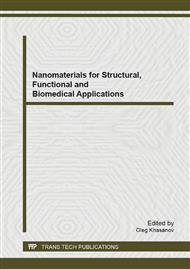[1]
World Nanomaterials. Industry study with Forecasts for 2016 & 2021, (2012) Study No. 2871.
Google Scholar
[2]
M. Hasanzadeh, N. Shadjou, L. Saghatforoush, R. Mehdizadeh, S. Sanati. Electrocatalytic oxidation of selected parabens on zinc hydroxide nanoparticles, Catal. Commun. 19 (2012) 10-16.
DOI: 10.1016/j.catcom.2011.12.012
Google Scholar
[3]
P. Willi, P.S. Chandra. Synthesis and characterization of alginate coated zinc calcium phosphate nanoparticles for intestinal delivery of insulin. Process Biochem. 47(5) (2012) 882-886.
DOI: 10.1016/j.procbio.2012.01.018
Google Scholar
[4]
Z. Fan, J.G. Lu. Zinc oxide nanostructures: synthesis and properties. J. Nanosci. Nanotechnol. 5(10) (2005) 1561-1573.
Google Scholar
[5]
N. Serpone, D. Dondi, A. Albini. Inorganic and organic UV filters: Their role and efficacy in sunscreens and suncare products. Inorg. Chim. Acta. 360 (2007) 794-802.
DOI: 10.1016/j.ica.2005.12.057
Google Scholar
[6]
F. Piccinno, F. Gottschalk, S. Seeger, B. Nowack. Industrial production quantities and uses of ten engineered nanomaterials for Europe and the world. J Nanopart Res. 14 (2012) 1109–1120.
DOI: 10.1007/s11051-012-1109-9
Google Scholar
[7]
S.B. Lovern, R.D. Klaper. Daphnia magna mortality when exposed to titanium nanoparticles and fullerene (C60) nanoparticles. Environ. Toxicol. Chem. 25 (2006) 1132-1137.
DOI: 10.1897/05-278r.1
Google Scholar
[8]
T. Li, B. Albee, M. Alemayehu, R. Diaz, L. Ingham, S. Kamal, M. Rodriguez, S. W. Bishnoi. Comparative toxicity study of Ag, Au, and Ag–Au bimetallic nanoparticles on Daphnia magna. Anal. Bioanal. Chem. 398(2) (2010) 689-700.
DOI: 10.1007/s00216-010-3915-1
Google Scholar
[9]
O. Bondarenko, K. Juganson, A. Ivask, K. Kasemets, M. Mortimer, A. Kahru. Toxicity of Ag, CuO and ZnO nanoparticles to selected environmentally relevant test organisms and mammalian cells in vitro: a critical review. Arch. Toxicol. Published Online, DOI 10. 1007/s00204-013-1079-4.
DOI: 10.1007/s00204-013-1079-4
Google Scholar
[10]
X. Zhu, L. Zhu, Y. Chen, S. Tian. Acute toxicities of six manufactured nanomaterial suspensions to Daphnia magna. J. Nanopart. Res. 11 (2009) 67-75.
DOI: 10.1007/s11051-008-9426-8
Google Scholar
[11]
S.W.Y. Wong, P.T.Y. Leung, A. B. Djurišić, K.M.Y. Leung. Toxicities of nano zinc oxide to five marine organisms: influences of aggregate size and ion solubility. Anal Bioanal Chem. 396 (2010) 609–618.
DOI: 10.1007/s00216-009-3249-z
Google Scholar
[12]
C. Blaise, F. Gagne´, J.F. Fe´rard, P. Eullaffroy. Ecotoxicity of selected nano-materials to aquatic organisms. Environ Toxicol. 23(5) (2008) 591–598.
DOI: 10.1002/tox.20402
Google Scholar
[13]
M.E. Pettitt, J.R. Lea. Minimum physicochemical characterisation requirements for nanomaterial regulation. Environment International. 52 (2013) 41–50.
DOI: 10.1016/j.envint.2012.11.009
Google Scholar
[14]
A. Turner, D. Brice, M.T. Brown. Interactions of silver nanoparticles with the marine macroalga, Ulva lactuca. Ecotoxicology. 21(1) (2012) 148-154.
DOI: 10.1007/s10646-011-0774-2
Google Scholar
[15]
A. Yamamoto, R. Honma, M. Sumita, T. Hanawa. Cytotoxicity evaluation of ceramic particles of different sizes and shapes. J. Biomed. Mater. Res. 68A (2004) 244-256.
DOI: 10.1002/jbm.a.20020
Google Scholar
[16]
J.P. Bohnsack, S. Assemi, J.D. Miller, D.Y. Furgeson. The Primacy of Physicochemical Characterization of Nanomaterials for Reliable Toxicity Assessment: A Review of the Zebrafish Nanotoxicology Model. Nanotoxicity. Methods Mol. Biol. 926 (2012).
DOI: 10.1007/978-1-62703-002-1_19
Google Scholar
[17]
R.D. Handy, F. von der Kammer, J.R. Lead, M. Hassellöv, R. Owen, M. Crane. The ecotoxicology and chemistry of manufactured nanoparticles. Ecotoxicology. 17(4) (2008) 287-314.
DOI: 10.1007/s10646-008-0199-8
Google Scholar
[18]
D. Kwon, S.H. Lee, J. Kim, T.H. Yoon. Dispersion, fractionation and characterization of sub-100nm P25 TiO2 nanoparticles in aqueous media. Tox. and Env. Health Sc. 2(1) (2010) 78-85.
DOI: 10.1007/bf03216516
Google Scholar
[19]
A.V. Kiselev, Intermolecular interactions in adsorption and chromatography, High school, Moscow, in Russian, (1986).
Google Scholar
[20]
S. J. Ormerod, K. R. Wade. The role of acidity in the ecology of Welsh lakes and streams. Acid Waters in Wales. Monographiae Biologicae. 66 (1990) 93-119.
DOI: 10.1007/978-94-009-1894-8_8
Google Scholar
[21]
T.S. Minakova. Adsorption processes on solid surfaces, Tomsk State University, Tomsk, in Russian, (2007).
Google Scholar
[22]
E.N. Yunda, S.I. Milyaeva. Determination of electrokinetic potential in suspensions based on zinc oxide nanopowders. Proceedings of XVII International Scientific and Practical Conference of Students, PhD-students and Young Scientists Modern Techniques and Technologies, Tomsk Polytechnic University, Tomsk (2012).
DOI: 10.1109/mtt.2001.983799
Google Scholar


